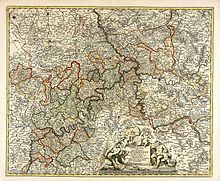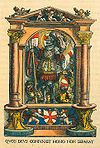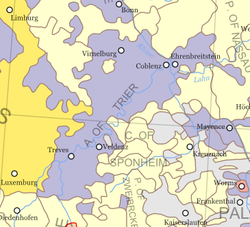- Electorate of Trier
-
"Bishop of Trier" redirects here. For the contemporary Bishop of Trier, see Roman Catholic Diocese of Trier.
Electorate of Trier
Kurtrier / Kurfürstentum Trier (German)
Électorat de Trèves (French)State of the Holy Roman Empire ← 
898–1801  →
→
 →
→
 →
→

Flag Coat of arms The Electorate of Trier in 1648 Capital Trier Language(s) French, Latin, Luxembourgish, Moselle Franconian German Religion Roman Catholic Government Principality Historical era Middle Ages - Autonomy granted 772 - Reichsfreiheit status 898 (confirmed 902) - Raised to Electorate between 1189 and 1212 - Trier city rights 1212 - Joined Electoral
Rhenish Circle
1512- Treaty of Lunéville 9 February, 1801 - Reconstituted as
G/D Lower Rhine
9 June 1815The Electorate of Trier (German: Kurfürstentum Trier or Kurtrier) was an ecclesiastical principality of the Holy Roman Empire that existed from the end of the 9th to the early 19th century. Consisting of the temporal possessions of the larger Archbishopric of Trier (German: Erzbistum Trier), it was ruled by the Archbishop in his function as prince-elector of the empire. The capital of the electorate was Trier, with its main residence being Coblence from the 16th century onward. The electorate was secularized in 1803 during Napoleonic rule.
Contents
History
Trier, as the important Roman provincial capital of Augusta Treverorum, had been the seat of a bishop since Roman times. It was raised to archiepiscopal status during the reign of Charlemagne, whose will mentions the bishoprics of Metz, Toul and Verdun as its suffragans.
 Map from the 18th century by Frederik de Wit
Map from the 18th century by Frederik de Wit
The bishops of Trier were already virtually independent territorial magnates in Merovingian times. In 772 Charlemagne granted Bishop Wiomad complete immunity from the jurisdiction of the ruling count for all the churches and monasteries, as well as villages and castles that belonged to the Church of St. Peter at Trier. In 816 Louis the Pious confirmed to Archbishop Hetto the privileges of protection and immunity granted by his father.
At the partition of the Carolingian empire at Verdun in 843, Trier fell to Lothair; at the partition of Lotharingia at Mersen in 870, it fell to the East Frankish kingdom, which developed into the Kingdom of Germany.
Archbishop Radbod received in 898 complete immunity from all taxes for the entire episcopal territory, granted by Zwentibold, the natural son of Emperor Arnulf of Carinthia, who reigned briefly as King of Lotharingia and, under great pressure from his independent nobles, desperately needed a powerful ally. The gift cemented the position of the archbishops as territorial lords in their own right. Following Zwentibold's assassination in 900, the handlers of the child-king Louis courted Radbold in their turn, granting him the district and city of Trier outright, permission to impose customs duties and the right to a mint (as much a symbol of independent authority as an economic tool). From the court of Charles the Simple, he obtained a final right of election of the Bishop of Trier by the chapter, free of Imperial interference.
In early modern times, the Electorate of Trier still encompassed territory along the Moselle River between Trier, near the French border, and Koblenz on the Rhine. Since early 13th century the Archbishop of Trier, as holder of an imperial office was traditionally an Imperial Elector of the German king. The purely honorary office of Archchancellor of Gaul arose in the 13th century. In this context that was taken to mean the Kingdom of Arles, or Burgundy, technically from 1242 and permanently from 1263, and nominally until 1803. Arles along with Germany and the medieval Kingdom of Italy was one of the three component kingdoms of the Holy Roman Empire.
The last elector, Clemens Wenceslaus of Saxony, resided exclusively in Koblenz after 1786. From 1795, the territories of the Electorate on the left bank of the Rhine were under French occupation; in 1801, they were annexed and a separate French-controlled diocese established under Bishop Charles Mannay. In 1803, the French diocese assumed control of the whole diocese and what was left of the electoral territory on the eastern bank of the Rhine was secularized and annexed by Nassau-Weilburg in 1803.
Archbishops and prince electors of Trier
Archbishops of Trier
To 1000
- Radbod 883–915
- Rudgar 915–930
- Rudbrecht 930–956
- Heinrich I 956–964
- Dietrich I 965–977
- Egbert 977–993
- Ludolf 994–1008
1000 to 1200
- Megingod 1008–1015
- Poppo von Babenberg 1016–1047
- Eberhard 1047–1066
- Kuno I von Wetterau (Conrad) 1066-1066
- Udo von Wetterau 1066–1078
- Egilbert 1079–1101
- Bruno 1101–1124
- Gottfrid 1124–1127
- Meginher 1127–1130
- Adalberon von Munsterol 1131–1152
- Hillin von Fallemanien 1152–1169
- Arnold I 1169–1183
- Fulmar 1183–1189
Archbishop-Electors of Trier
1200 to 1500
- John I 1189–1212
- Theodoric II (Dietrich von Wied) 1212–42
- Arnold II von Isenburg 1242–59
- Heinrich I von Finstingen 1260–86
- Bohemond I von Warnesberg 1286–99
- Diether von Nassau 1300–07
- Heinrich II von Virneburg 1300–06 (in opposition)
- Baldwin von Luxemburg 1307–54
- Bohemond II von Saarbrücken 1354–61
- Kuno II von Falkenstein 1362–88
- Werner von Falkenstein 1388–1417
- Lenihan von Weideburg 1417–1419
- Otto von Ziegenhain 1419–30
- Rhaban von Helmstadt 1430–38
- Jakob von Sierk 1439–56
- Johann II of Baden 1456–1503
From 1500
- Jakob von Baden 1503–11
- Richard von Greiffenklau zu Vollrads 1511–31
- Johann von Metzenhausen 1531–40
- Johann Ludwig von Hagen 1540–47
- John of Isenburg-Grenzau 1547–56
- Johann von der Leyen 1556–67
- Jakob von Eltz-Rübenach 1567–81
- Johann von Schönenberg 1581–99
- Lothar von Metternich 1599–1623
- Philipp Christoph von Sötern 1623–52
- Karl Kaspar von der Leyen-Hohengeroldseck 1652–76
- Johann Hugo von Orsbeck 1676–1711
- Charles Joseph of Lorraine 1711–15
- Franz Ludwig of Palatinate-Neuburg 1716–29
- Franz Georg von Schönborn-Buchheim 1729–56
- Johann Philipp von Walderdorf 1756–68
- Prince Clemens Wenceslaus of Saxony 1768–1803[1]
See also
References
- ^ From 1794, after the French conquest of the Imperial territories on the left-bank of the Rhine, Clemens Wenceslaus of Saxony was archbishop with effect on the right bank only.
External links
- (German) Die Bischöfe von Trier
- Diocese of Trier in the 1908 Catholic Encyclopaedia
Links to related articles  Members of the Electoral College of the Holy Roman Empire following the Golden Bull of 1356Added from 1803–06
Members of the Electoral College of the Holy Roman Empire following the Golden Bull of 1356Added from 1803–06 Prince of Regensburg
Prince of Regensburg
 Grand Duke of Salzburg (1803–05)
Grand Duke of Salzburg (1803–05)
 Grand Duke of Würzburg (1805–06)
Grand Duke of Würzburg (1805–06)
 Duke of Württemberg
Duke of Württemberg
 Margrave of Baden
Margrave of Baden
 Landgrave of Hesse-Kassel
Landgrave of Hesse-Kassel Swabian League (1488–1534) of the
Swabian League (1488–1534) of the  Holy Roman Empire
Holy Roman EmpireImperial Cities Aalen · Augsburg · Biberach · Bopfingen · Dinkelsbühl · Donauwörth · Esslingen · Giengen · Heilbronn · Isny · Kaufbeuren · Kempten · Leutkirch · Lindau · Memmingen · Nördlingen · Pfullendorf · Ravensburg · Reutlingen · Schwäbisch Gmünd · Schwäbisch Hall · Überlingen · Ulm · Wangen · Weil · Wimpfen
Nobility St George's Shield (Gesellschaft von Sanktjörgenschild)Territories Württemberg · Brandenburg-Ansbach · Baden · Bavaria · Bayreuth · Electoral Palatinate · Hesse · Mainz · Trier Electoral Rhenish Circle (1512–1806) of the Holy Roman Empire
Electoral Rhenish Circle (1512–1806) of the Holy Roman EmpireElectorates 
Other territories Catholic League (1609–35) within the  Holy Roman Empire
Holy Roman Empire Categories:
Categories:- Former principalities
- Former countries in Europe
- States of the Holy Roman Empire
- States and territories established in 898
- States and territories disestablished in 1801
- 1801 disestablishments
- Trier
- Electoral Rhenish Circle
- History of Rhineland-Palatinate
- History of the Rhineland
- Prince-Bishops of the Holy Roman Empire
- Prince-Bishops of Germany
- Electors of Trier
Wikimedia Foundation. 2010.

